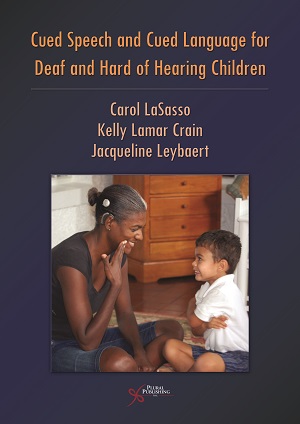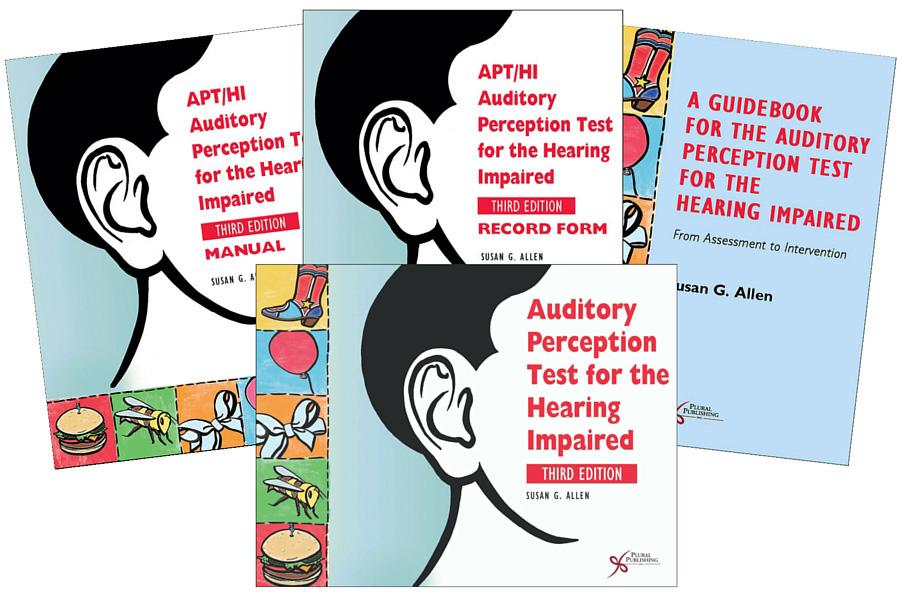
Cued Speech and Cued Language for Deaf and Hard of Hearing Children
First Edition
Carol LaSasso, Kelly Lamar Crain, Jacqueline Leybaert
Details: 606 pages, B&W, Softcover, 7" x 10"
ISBN13: 978-1-59756-334-5
© 2010 | Available
For Instructors
Purchase
For speech and hearing professionals interested in natural language acquisition, the development of reading, and academic achievement of deaf and hard of hearing children this book provides a multi-disciplinary perspective on the research and practical applications of cued speech and cued language. It is also appropriate as a textbook for graduate courses in deaf education programs as well as libraries of schools serving deaf children across the country. Theoretically and empirically based, this book is a vital source of information to any advocate, professional, or parent of a deaf child.
Readers of this book will learn that cueing has moved far beyond Cornett's 1966 invention of Cued Speech. This is true in terms of its use (by whom, how, and for what purposes); its status as a means of first-order language transmission; and cross-disciplinary contributions to numerous other fields of study, including: linguistics, psycholinguistics, cognition, speech science, hearing science, reading, and deaf education. Our understanding of visual language and communication has been enhanced by the inclusion of Cued Speech in academic dialogues by highlighting the similarities and differences among spoken, signed, and cued language. The book also covers the latest computer-generated aids to communication, which are either being developed for use with Cued Speech or were conceived because of Cued Speech. The expanding role of Cued Speech in the lives of hearing and deaf individuals (e.g., developmental, social, academic) is also discussed. Finally, readers of this book will understand how the case of Cued Speech lends further support to the notion that children, regardless of hearing status, have an irrepressible predisposition to acquire language, whether signed, spoken, or cued, whether alphabetic or tonal.
Reviews
"The editors of this volume clearly hope to encourage more research on and the use of CS/L. They have, toward these ends, compiled chapters (and some full or partial reprints of previous publications) from authors in Belgium, France, Spain, and the USA to provide a data base upon which to build . . . If you want to learn about Cued Speech/Language - or if you are interested in the possible integration of visual and auditory information for acquisition of language - this is a book you should read . . . This is a unique volume however, and readers will find it interesting at a number of levels. It could provoke re-thinking of some long-held attitudes about the language potential of deaf children, processing of multi-modal language input, and even the nature of the relation between languages and the modalities through which they are represented. And, it provides in one location what is known, thought, and hoped about the contributions of Cued Speech and Language to deaf children's development. I recommend this book to anyone who wants to learn more about these topics."
—Patricia Spencer, PSpencer Consulting LLC, Rockport, USA, International Journal of Audiology (2011)
SECTION 1: CUED SPEECH AND CUED LANGUAGE
- Chapter 1: Why a Book about Cued Speech and Cued Language and Why Now? Carol LaSasso
- Chapter 2 Fundamental Principles of Cued Speech and Cued Language Thomas Shull & Kelly Lamar Crain
- Chapter 3 Cued Language: What Deaf Native Cuers Perceive of Cued SpeechMelanie Metzger & Earl Fleetwood
- Chapter 4 Psycholinguistic Study of Phonological Processes in Deaf Adult Cuers Daniel Koo & Ted Supalla
SECTION II: CUED SPEECH FOR PHONOLOGICAL PERCEPTION
- Chapter 5 Audiovisual Phonology: Lipreading and Cued Lipreading Jesus Alégria
- Chapter 6 Cued Speech for Enhancing Speech Perception of Individuals with Cochlear Implants Jacqueline Leybaert, Cécile Colin, & Catharine Hage
SECTION III: CUEING FOR NATURAL LANGUAGE ACQUISITION
- Chapter 7 Early Linguistic Input Received by a Deaf Child Exposed to la Palabra Complementada During the Pre-Linguistic Period Ignacio Moreno-Torres & Santiago Torres
- Chapter 8 Early Language Development of Congenitally Deaf Twins of Deaf Parents who are Native Cuers of American English Kelly Lamar Crain
- Chapter 9 Experiences and Perceptions of Cueing Deaf Adults in the U.S. Kelly Lamar Crain and Carol LaSasso
- Chapter 10 A Bilingual (ASL and Cued American English) Program for Deaf and Hard of Hearing Students: Theory to Practice Kitri Larson Kyllo
SECTION IV: CUED LANGUAGE FOR THE DEVELOPMENT OF READING
- Chapter 11 Cued Speech for the Development of the Alphabetic Principle Jacqueline Leybaert, Stephanie Colin, & Carol LaSasso
- Chapter 12 Cued Language for the Development of Reading Comprehension Carol LaSasso and Kelly Lamar Crain
- Chapter 13 Phonological Awareness, Short Term Memory, and Fluency in Hearing and Deaf Individuals of Different Communication Backgrounds Daniel Koo, Kelly Lamar Crain, Carol LaSasso, and Guinevere Eden
- Chapter 14 Generative Rhyming Abilities of 10-14 Year Old Readers who are Deaf Kelly Lamar Crain and Carol LaSasso
SECTION V: CUED SPEECH FOR ATYPICAL POPULATIONS
- Chapter 15 Children with Auditory Neuropathy/Auditory Dys-synchrony: The Value of Cued Speech in the Face of an Uncertain Language Development Trajectory Michelle Arnold & Charles Berlin
- Chapter 16 Applications of Cued Speech with Deaf Children with Additional Disabilities Affecting Language Development Donna Morere
- Chapter 17 Cued Spanish as L1: Teaching la Palabra Complementada to Spanish-Speaking Parents of Deaf Children in the U.S. Claire Klossner & Kelly Lamar Crain
SECTION VI: CUED SPEECH/CUED LANGUAGE ON THE HORIZON
- Chapter 18 Lipreading, the Lexicon, and Cued Speech Lynne Bernstein, Edward Auer, & Jintao Jiang
- Chapter 19 Analysis of Cued Speech Production and Perception: Toward a Complete Text-to-Cued Speech Synthesizer Virginie Attina, Guillaume Gibert, Marie-Agnès Cathiard, Gerard Bailly & Denis Beautemps
- Chapter 20 Development of Speechreading Supplements Based on Automatic Speech Recognition Paul Duchnowski, David Lum, Jean Krause, Matthew Sexton, Maroula Bratakos, and Louis Braida
- Chapter 21 Automatic Cued Speech Jean Krause, Paul Duchnowski, & Louis Braida
- Chapter 22 An Automatic Visible Speech Supplement for Deaf Individuals Speech Comprehension in Face-to-Face and Classroom Situations Dominic Massaro, Miguel Carreira-Perpiñán, & David J. Merrill
- Chapter 23 A Version of the Educational Interpreter Performance Assessment for Cued Speech Transliterators: Prospects and Significance Jean Krause, Brenda Schick, & Judy Kegl
- Chapter 24 How Cued Speech is Processed in the Brain: Directions for Future Research Mario Aparicio, Philippe Peigneux, Brigitte Charlier & Jacqueline Leybaert
Index

Auditory-Verbal Therapy: For Young Children with Hearing Loss and Their Families, and the Practitioners Who Guide Them
First Edition
Warren Estabrooks, Karen MacIver-Lux, Ellen A. Rhoades
Details: 602 pages, B&W, Hardcover, 7" x 10"
ISBN13: 978-1-59756-888-3
© 2016 | Available

Auditory Perception Test for the Hearing Impaired (APT/HI)
Third Edition
Susan G. Allen
Details: Full Color, Spiral-Bound Test Book, 8.5" x 11", plus Guidebook and Companion website with supplementary materials
ISBN13: 978-1-59756-590-5
© 2016 | Available

Assessing Listening and Spoken Language in Children with Hearing Loss
First Edition
Tamala S. Bradham, K. Todd Houston
Details: 496 pages, B&W, Softcover, 7" x 10"
ISBN13: 978-1-59756-576-9
© 2015 | Available

Literacy and Deafness: Listening and Spoken Language
Second Edition
Lyn Robertson
Details: 400 pages, B&W, Softcover, 6" x 9"
ISBN13: 978-1-59756-557-8
© 2014 | Available

The Deaf Child in a Hearing Family: Nurturing Development
First Edition
Arthur Boothroyd, Janice Gatty
Details: 256 pages, B&W, Softcover, 6 x 9"
ISBN13: 978-1-59756-394-9
© 2012 | Available

Deaf Culture: Exploring Deaf Communities in the United States
Second Edition
Irene W. Leigh, Jean F. Andrews, Raychelle L. Harris, Topher González Ávila
Details: 384 pages, B&W, Softcover, 7" x 10"
ISBN13: 978-1-63550-173-5
© 2022 | Available



